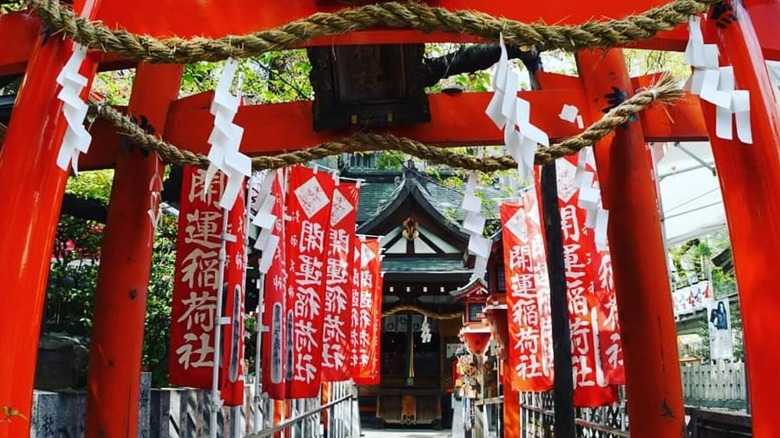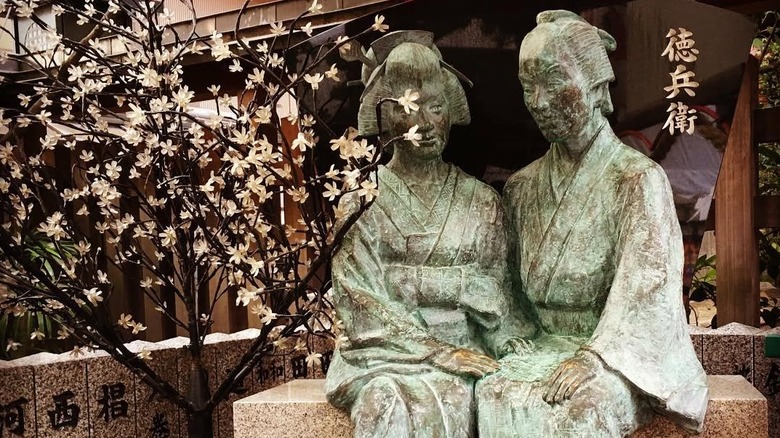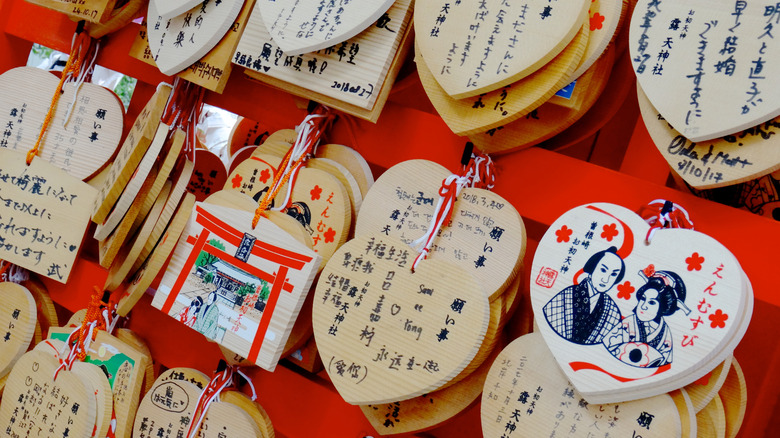Japan's Version Of Romeo And Juliet Still Captivates Visitors At This Historic Shrine
"O Romeo, Romeo, wherefore art thou Romeo?" Spoiler alert, Juliet — he's dead. While a modern-day queen probably would have woken up, seen Romeo dead, and then thanked her lucky stars she didn't end up hitching her wagon to someone as dumb as him, this is Shakespeare and thus must end in tragedy. If you've never read the play and feel that this spoiled the ending: "Romeo and Juliet" has been in print since 1597 — you've had plenty of time. Speaking of "Romeo and Juliet," on the other side of the world from Verona, Italy, (a popular town for Shakespeare lovers where you can visit the "home" of Juliet) sits a shrine dedicated to two real-life lovers, whose story rivals the works of Shakespeare.
Osaka, Japan, is home to the Ohatsu Tenjin Shrine — a place where people come from all over the world to send wishes and prayers to the spirits of the two lovers, Ohatsu and Tokubei, who are said to watch over the shrine. With February 14 swiftly approaching, what better way to spend the day of love than by visiting Valentine's Day destinations like this romantic shrine?
Ohatsu Tenjin Shrine's tragic love story
Perhaps a slightly less fairytale-esque story than that of Romeo and Juliet who came from royal blood, the protagonists here were a sex worker and an employee in a soy sauce factory. The tale gained popularity over 300 years ago in 1703 when Japanese dramatist Chikamatsu Monzaemon wrote "Love Suicides at Sonezaki," a puppet theater play based on a historical double suicide that took place at the shrine. The shortened version of this tale goes something like this: Ohatsu and Tokubei were two lovers who were destined to be together but couldn't be in the public eye because of the differences in their social standings. So, they decided to date in secret. Tokubei worked in a factory run by his uncle, who told Tokubei that if he married an associate's niece, he would give him the factory. Tokubei told him no, and furious, his uncle fired him and kicked him out of his home.
Feeling ashamed and hopeless, Tokubei decides to take his own life by performing seppuku, an honorable method of death by sword done by samurai. Before doing so, Tokubei goes to Ohatsu and asks her if she wants to be with him for all eternity, and when she agrees, they go to the forest, tie themselves to a tree, and die together. The next day, the couple was found on the grounds of the shrine — where today, visitors pass through the red gates in search of their own passionate love affair (though hopefully one that doesn't end in so much tragedy).
Visiting the Ohatsu Tenjin Shrine
Sightseers exploring Japan destinations outside Tokyo can visit the shrine to purchase wooden plaques called ema, on which they can write wishes and prayers to be sent up to the spirits. One side of the ema is left empty for patrons' wishes, and the other is typically decorated with a particular shrine or temple in mind. Many of the ema at Ohatsu Tenjin Shrine are adorned with images of cherry blossoms or the couple side by side. For around $4, visitors can purchase their own ema to write a wish from the heart.
Though the couple's love story is what brought popularity to the shrine, some say it has been around for more than 1,300 years and is one of Osaka's most valuable Shinto monuments (Shinto meaning "the way of the gods" in Japanese). Aside from celebrating eternal love, people can come here for regularly hosted events such as a flea market on the first Friday of every month and the Mame Make Matsuri Festival — a bean-throwing celebration. Free to enter, the Ohatsu Tenjin Shrine is about a 30-minute walk from most of Osaka's major tourist attractions, like the National Museum of Art, the Umeda Sky Building, and Nakanoshima Park. It's also an under 10-minute walk southeast of Osaka Station. If you find yourself in Osaka on Valentine's Day, stop by the shrine, make a wish, hang your plaque, and learn more about the tragic love story between Ohatsu and Tokubei.


